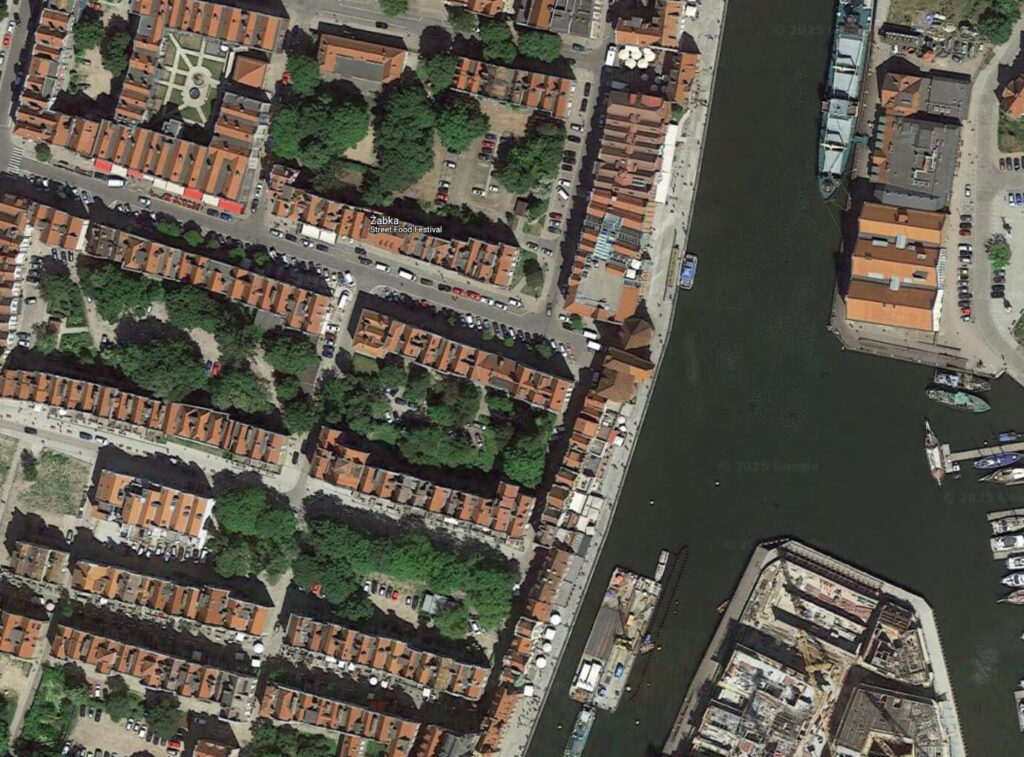Description of the Gdansk Crane object
The project was carried out in the historic building of the Gdansk Crane, the largest and oldest surviving medieval crane in Europe. It is located in the very center of Gdansk, on the Motlawa River, at the end of Szeroka Street, a location with limited transport and logistical possibilities. The facility is under the care of the conservation officer.

The lower part of the Crane and its two towers were made of brick, while the upper part was made of wood. The Crane building, destroyed during World War II, was rebuilt in the 1950s and 1960s, preserving its historic character. After the reconstruction was completed in 1962, the Gdansk Crane, adjacent to the Maritime Culture Center building, became a branch of the National Maritime Museum in Gdansk and was opened to the public.
Scope of the project work
The work was carried out as part of a broader project called “Preservation, renovation and modernization of the Gdansk Crane – a branch of the National Maritime Museum in Gdansk with the creation of a new permanent exhibition”, carried out between 2020 and 2024.
As a subcontractor in the field of teletechnology, we implemented the following systems in the Crane building:
- ICT network
- Intrusion alarm system
- Access control
- Television surveillance system (CCTV)
- Fire alarm system
- Voice evacuation system (DSO)
- BMS and microclimate system for exhibit protection
Our responsibilities included:
- Preparation of technical documentation.
- Revision of the project in the context of the exhibition.
- Implementation of the installation (cabling, installation of equipment).
- Commissioning of the systems.
- Maintenance and upkeep of the systems for 6 years.
- Coordination of inter-industry construction work.
Design challenges and solutions applied
Due to the historic nature of the building and, most importantly, the care of the conservationist, all work had to be carried out strictly according to the conservationist’s guidelines. They prevented, for example, the use of standard cable solutions in wooden structures.
Solution: in accordance with the conservator’s requirements, we utilized black, halogen-free plastic and steel components, powder-coated in black. These materials were chosen to seamlessly integrate with the historic wooden structure of the Gdansk Crane, particularly within the so-called lift area, where all installation cables were carefully routed.
Design and implementation of the BMS system
The tender documentation did not include the design of the BMS system, which turned out to be necessary to meet the design objectives.
Solution: we independently developed the system design from scratch, taking into account the need for climate management, microclimate control and integration with other systems.
Implementation of water mist extinguishing system control
The problem turned out to be the requirement to update the original control design of the water mist extinguishing system.
The solution: we made a new water mist nozzle control design in accordance with current standards. It required the development of more than 30 control modules.
Integration of new systems into existing ones
The Crane building was to be monitored and managed from the adjacent Marine Culture Center building.
The solution: we integrated the new teletechnical systems with the older OKM systems.
Logistical problems
The Crane’s location in the center of Gdansk makes it difficult to access the facility especially during celebrations such as the Dominican Fair.
Solution: coordination of logistics and transportation activities taking into account current and expected traffic volume and availability of free parking spaces for supply vehicles.
The project was executed from March 14, 2023, to April 30, 2024. The implementation phase commenced with site preparation, which involved the installation of monitoring and access control systems, as well as comprehensive fire protection measures throughout the construction process.
In the next phase, we undertook demolition work, which involved the removal of outdated installations. Subsequently, we installed new teletechnical systems, ensuring close coordination of our activities with the construction schedules of other subcontractors.
Project results and benefits for the Client
The implementation of the project made it possible to remotely manage the Gdansk Crane building, including control of the BMS system (lighting, air conditioning and others), using a single platform, located in the adjacent building of the Maritime Culture Center. By integrating the new systems with the old, we have reduced implementation costs and accelerated the work. OKM employees can continue to use a familiar work environment.
In addition to completing the aforementioned teletechnical installations, we also provided technical and subcontract documentation and user manuals. We provided training for users of the systems (BMS, security, CCTV).
An additional element that was developed in response to the investor’s needs is a climate monitoring system integrated with the BMS. This platform, thanks to the use of wireless technology, allows for accurate measurement of the storage conditions of exhibits and appropriate response to its changes. The system can operate autonomously outside the BMS and allows for scaling not only within a given building, but also to the museum’s other infrastructure facilities